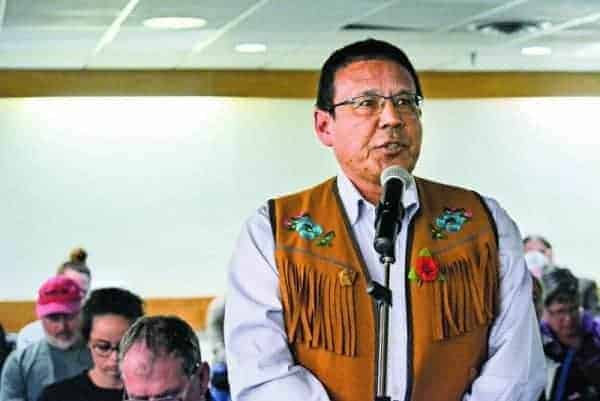The federal department responsible for lands in Ndilo has yet to begin cleaning up arsenic-laden soil next to the community's K'alemi Dene School, and is not putting up arsenic warning signs in the meantime.

Avery Zingel/NNSL photo
In an email on Monday, Kimberly Walker, spokesperson for Crown-Indigenous Relations and Northern Affairs Canada (CIRNAC), said the department is working with the Det'on Cho Corporation, the development arm of the Yellowknives Dene First Nation, to determine “the most effective solution to remediate the area of elevated arsenic levels in close proximity to the school.”
Walker added that “CIRNAC does not have plans to install warning signs in Ndilo.”
Ernest Betsina, chief of the Yellowknives Dene First Nation in Ndilo, said he and the Yellowknives Dene council will soon meet with CIRNAC to discuss next steps.
“I would like things to go a little quicker,” Betsina said on Tuesday.
“But just to reassure the community, we're trying to work within the system to try to get (the soil issue) resolved as soon as we can.”
In May, Betsina called on the federal and territorial governments to set aside any jurisdictional disputes and put up warning signs in Ndilo at arsenic “hotspots” – areas of soil with elevated levels of arsenic as a result of past mining activities at Giant Mine.
The hotspots generally have arsenic concentrations greater than 900 milligrams per kilogram of soil (mg/kg).
Health Canada states that average levels of arsenic in soil in Canada range from 4.8 to 13.6 mg/kg.
Betsina's appeal was reinforced by the Giant Mine Oversight Board, the independent body overseeing the remediation of Giant Mine.
The board urged the federal and territorial governments in May to cooperate in putting up warning signs at the hotspots “as soon as possible,” and to create a plan to remediate the contaminated soils.
Matthew Spence, regional director general of CIRNAC, told Yellowknifer on June 4 that the department was “going to deal with the problem and therefore we won’t need signs, because we will have remediated that area of high concentration.”
After meeting with CIRNAC officials on June 19, Betsina said he was informed that work to clean up the hotspots would begin within the next month.
But nearly three months after that meeting, and about four years after the hotspots were first identified, if and when the contaminated soils will be cleaned up remains unclear.
Det'on Cho recently took fresh soil samples from areas near the school and, on Friday, submitted a report with an analysis and recommendations to CIRNAC.
John Henderson, the corporation's chief operating officer, said he couldn't speak about the contents of the report because neither the community nor CIRNAC had seen it yet.
He said there will soon be a meeting between CIRNAC and the community to discuss the report and what, if any, actions should be taken.